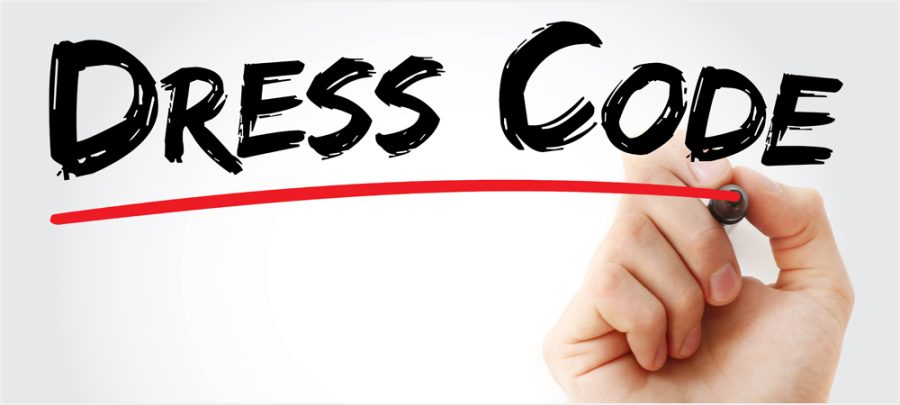West Reacts to Dress Code Reminder
Nov 30, 2021
Students received a dress code reminder on Nov. 16 from Dean Tim Dykes. The email consisted of the A-I list of prohibited depictions and garments seen on the Administrative Procedure: Student Appearance since its last update on Aug. 10, 2021, which removed the ban on hats and hoods.
Upon receiving the email, a question lingered among the student body and staff: why now?
“It seemed a little sudden because we are already at the end of the first semester, and it just seems random to do this now. I feel like it should have been talked about at the beginning of the first semester or second semester,” English instructor Dena Lichterman said. “I think any time there’s going to be enforcement of a rule, it’s important for the administration to be transparent and explain why they are instituting these rules. I don’t feel like that was clear, which is why I think so many students have questions and are upset about it.”
According to Dean Amy Tucker, “When we returned to school full-time at full capacity in August of 2021, our continued focus was on safety. There was a significant amount of adjustment for everyone – both students and adults. Because of this, the deans have sent out periodic reminders regarding policies and procedures.”
Of recent, staff members have inquired about expectations for the dress code policy in particular. Additionally, both students and teachers have asked the deans about how to follow through with procedures.
“I’ve heard a lot from my teachers. Some are for a stricter dress code and want to reprimand students who don’t obey the dress code,” junior Evelyn Herbert said. “Others have expressed that they think it’s your choice to wear what you want, and they don’t care what their students wear. They don’t think the school should be controlling what kids wear.”
Some teachers believe that it’s essential for the administration to continue reminding students of the policies and procedures in place.
“I think it’s a good idea for administration to remind students what the rules are because sometimes they’re not clear,” physics instructor Martha Lietz said. “I have dress-coded students before, and often their answer was ‘the dress code isn’t a rule’ and things similar to that.”
That being said, some teachers have noticed that the dress code reminder did little to keep students in line with the policy.
“To me, it looks like anything goes. If you got it, flaunt it. I mean, seriously, I’m seeing sports bras,” English instructor Michele Lewis said. “They sent out an email to all the students, but I swear I noticed as soon as the email went out, more of the zip-up hoodies unzipped yesterday (Nov. 16) than I had seen in previous days. It’s like students are challenging the dress code.”
Upon reading through the prohibited list of garments and depictions, some teachers agreed with the policy as long as it didn’t deter students from openly expressing themselves safely.
“I am against tee-shirts that have alcohol and drug references or any sort of inappropriate things like that, but otherwise, I feel like if you feel good about yourself and that’s what you want to wear, then wear it,” Feminist Club co-sponsor and English instructor Michelle Hettinger said.
A conversation sparked among students after reading the email reminder.
“I think that the code is very reasonable, and one shouldn’t be dressed in a way that breaks the code even if there wasn’t one,” senior David Bodansky said. “This is high school, not party city.”
As the discussion about dress codes policies grew, the conversation also centered towards Niles West’s policy, specifically regarding self-expression.
According to senior Dharma Delahanty, “Clothes are self-expression, a way to be creative and show who you are. I’m thankful Niles West’s dress code isn’t as strict as some other schools I’ve heard of and allows that.”
While some students are satisfied with Niles West’s current dress code policy, others have communicated discontent.
“It’s not distracting anyone,” senior Cadence Nixon said. “There’s like no harm to the learning process going on. I can understand the, ‘Hey don’t promote drugs and violence on your shirts,’ but my body shouldn’t have to be regulated for other people. If other people can’t stop staring, that’s their problem, not mine.”
As the dialogue continued, some students, especially female students, stated they believed the dress code policy was specifically targeting and shaming them.
“I think parts of it are understandable, but ‘exposed midriffs’ is targeting a popular girl’s fashion trend. Nothing is inappropriate about someone’s stomach,” Herbert said. “I think if teachers were allowed to send people down to the office for simply showing a little skin, that’s completely disrupting that students’ learning.”
Others also mentioned concerns about the rules being applied unequally.
According to senior James Knott, “Most of the rules anyways are aimed towards girls unfairly especially because most of these things, again on the list, are worn mainly by women.”
On the other hand, others believe the dress code policy doesn’t focus on gender.
“It doesn’t say these are just for girls, everyone needs to abide by them. (The part that mentions) you can’t show your underwear, I think targets more guys because girls don’t really do that,” Accounting instructor Eric Lueder said. “I think if you want to take a cynical view of it and make a big issue and be like ‘this is all about girls and not guys,’ you can. I think if you’re looking to pick a fight, you can always find one. For me, this is the way to dress or not dress, guys or girls, and if you want to make more of it, go ahead.”
Another frequent topic of discussion among students and staff was the language of the dress code policy because of the 2018 student initiative started by Niles North’s student government to change the dress code policy.
“About four years ago, students from Niles North worked with the board to change the language of the dress code policy so it would be less bias, less gender bias, and so it feels like the dress code that was just shared with us does not reflect the students’ hard work from four years ago to change how the dress code was written,” Lichterman said.
While students in Niles North’s student government were the first to address concerns about the dress code language, Niles West’s Feminist club followed suit, and together, they led the school board to update the Student Appearance section and remove sleeveless shirts from the prohibited list while also changing the wording surrounding the consequences of dressing in inappropriate attire.
“In 2018, the Fem club from North was the one that started the process, and then our Fem club joined them at the board meeting to talk about taking away the gender from the dress code, making it less misogynistic. I was under the impression that that was where we were. I just think that women, young women at our school, if they feel good with what they are wearing, then it’s fine that they wear it,” Hettinger said. “My bigger problem is, the notion is that they are distracting males, and if that is happening, then the males need to deal with that on their own, and I am anti slut-shaming, which seems to be what happens when we have a dress code. It’s the women who are told you can’t wear that. It seems when it comes down to it, it is against women.”
While it’s clear that students and staff discussed the dress code policy amongst themselves, a focal point was made as to whether a discussion was also being had at the administrative level.
“We apologize if anyone felt targeted by the email. The intent of the message was meant simply to remind everyone – all students – of our current dress code policy,” said Tucker. “No new information was included in the reminder email. The administrators have been discussing the dress code and ways in which we can change it. We are definitely open to discussion to hear students’ thoughts and suggestions regarding the current dress code. In fact, the deans have already scheduled one such meeting.”





freskida • Dec 17, 2021 at 4:37 PM
what an insightful article! i’m loving the holistic view that i got of the student and faculty perspective on dress-code regulations.